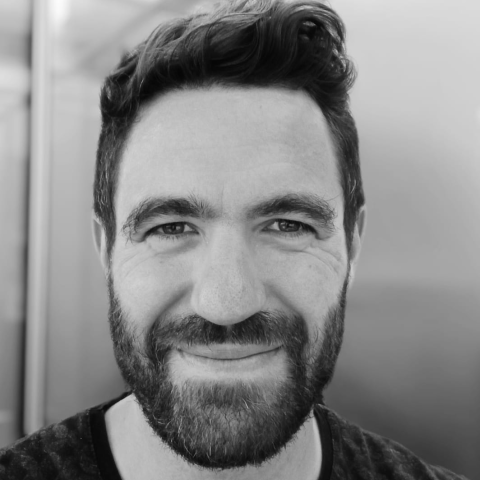SYLVAIN HARQUEL
Ingénieur de recherche (CNRS)
- Imprimer
- Partager
- Partager sur Facebook
- Partager sur X
- Partager sur LinkedIn
Permanent, Corps & Espace, Pôle Ingéniérie - Appui à la recherche

Thèmes de recherche
My research primarily focuses on innovative non-invasive brain stimulation, including robotized TMS, TMS-EEG mapping and closed-loop approaches, to study the healthy and pathological brain. I am particularly interested in understanding the neurophysiological mechanisms underlying stroke motor and cognitive impairment and recovery, with the ultimate goal of designing and optimizing neuromodulation-based rehabilitation therapies. I'm conducting this research as part of the body and space team. Within the pôle ingéniérie, I also work across the research teams of the lab on clinical and cognitive neuroscience projects requiring expertise in human electrophysiology or cortical stimulation. Finally, I am co-supervisor of the EEG and Neurostim platforms at the UAR IRMaGe neuroimaging facility.
Ongoing Projects
ANR SLEEPY-STROKE (as PI, ANR JCJC 2025 funding)
SLEEPY-STROKE is a research project aiming to better understand and improve recovery after stroke by studying and modulating sleep-like cortical dynamics (SLCDs, which are abnormal, slowed and simplified brain activity patterns observed in the affected hemisphere). Using robotized TMS-EEG and advanced neuroimaging, the project will track how SLCDs spread across motor and cognitive brain networks, how they change during recovery, and how they relate to patient outcomes. It will also test an innovative, personalized non-invasive brain stimulation protocol designed to attenuate SLCDs and trigger a beneficial disinhibition phase in the early subacute stage. By integrating advanced neurophysiological characterization with innovative neuromodulation strategies, SLEEPY-STROKE aims to pave the way for precision rehabilitation approaches in stroke recovery.
PhD & Post-doc: hiring in 2026-2027
CLOSED-LOOP (as PI, CERCOG 2025 funding)
This project aims to develop adaptive closed-loop brain state-dependent stimulation protocols. In particular, the goal is to design TMS-EEG closed-loop stimulation that could overcome known limitations, first by incorporating adaptive decision-making modeling to optimize for multiple parameters in parallel (stimulation location, orientation, intensity) while using a wide range of EEG readouts (evoked potentials, frequency-band power, connectivity, etc.), and by integrating state-of-the-art EEG real-time preprocessing to access any cortical target (including frontal, temporal, and occipital lobes).
PhD: S. Varmaghani (co-supervisor)
TiMeS (PI: Prof. Friedhelm Hummel, EPFL, Geneva)
This research project investigates changes in brain functions that occur after a stroke, and studies how these alterations are related to the recovery of different functions and the daily life of the patients. This is investigated by covering the first year after the initial incident at 4 time points (1st week, 3rd week, 3rd month and 12th month), with the use of multimodal and complementary neuroimaging techniques, including structural and diffusion MRI, resting-state EEG and TMS-EEG. The acquired knowledge will pave the way to develop tailored therapy approaches. These therapy approaches will be based on the individual characteristics of the patient.
ANR VISION-3E (PI: Anna Montagnini, INT, Marseille)
VISION-3E aims to gather behavioral and physiological evidence on the three key functions in the closed-loop processing of human visual perception - expectation, exploration, and exploitation - in order to better understand and model their interaction. The use of closed-loop stimulation approaches in the context of multistable perception will help us to understand the causal role of occipital and fronto-parietal networks in active visual processes involved in the resolution of perceptual rivalry.
PhD: S. Varmaghani (co-supervisor)
MAGTOC (PI: Mircea Polosan, CHUGA)
Deficient motor inhibition is observed in patients with obsessive-compulsive disorder (OCD). Evidence points toward the essential role of two cortical nodes, the pre-SMA and the inferior frontal cortex (IFC), in the brain network supporting response inhibition. This project consisted in a sham-controlled, double-blind and parallel design clinical trial, that aimed at enhancing cortical excitability within the right IFC using intermittent theta-burst stimulation delivered twice a day during two weeks. The stimulation target was individualized to each patient in respect to the maximum activation peak within the right IFC node of the activated motor inhibition network, as observed in fMRI scans during a stop-signal task. As a way to quantify the inhibitory process of the right IFC on the motor cortex, motor excitability was assessed before and after the iTBS cure using dual site TMS.
NEUROVEC (PI: Michel Guerraz)
Virtual reality systems are more and more frequently used in the field of learning but also in motor rehabilitation. One of the key points of the success of these systems is the experience of "presence" which is associated with the capacity of these technologies to develop in the static observer the sensation of moving in his virtual environment (vection). However, the simulation generates a sensory conflict (an optical flow specifying the movement of the self and vestibular stimuli specifying an immobility of the body). This conflict influences the temporal characteristics of the vection (i.e bistable perception) and consequently modifies the way users act in their virtual environment. The main objectives of our project will be to study the regulation of vection phenomenon through the use of non-invasive brain stimulation, by modulating one of its neural signature: alpha oscillations in sensorimotor and vestibular cortical networks.
Disciplines scientifiques
Clinical neurophysiology, non-invasive brain stimulation, electrophysiology, cognitive neuroscience, neuroimaging
Enseignement
Teaching
- Neurophysiological mechanisms of non-invasive brain stimulation (training for psychiatrists and clinical staff). STEP training of AFPBN (Asso. Fr. de Psychiatrie Biologique et de Neuropsychopharmacologie), Lyon. (since 2025)
- CM: Non-invasive brain stimulation. M2R NeuroPsy. & Neurosci. Cliniques, UGA. (since 2020, 3h)
- TD: Statistics. L2 Psychologie, UGA. (2014-2021)
Scientific dissemination / animation
- Member of the local steering committee of La Semaine du Cerveau (Brain Week)
- Organizer of neuroscience workshops for school audiences (for the national Fête de la Science and Semaine du Cerveau dissemination events)
Publications
https://scholar.google.com/citations?hl=en&user=w57Gz4cAAAAJ
idHAL: sylvain-harquel
https://www.researchgate.net/profile/Sylvain-Harquel
Oral communications
(last 6)
- Recovery-related changes in cortical reactivity based on modulation of intracortical inhibition after stroke. ECCN (European congress of clinical neurophysiology), Septembre 2025, London, UK.
- Les techniques de stimulation cérébrale non-invasives conventionnelles. Séminaire de printemps CerCoG, April 2024, Grenoble, France.
- Recovery-related changes in cortical reactivity based on modulation of intracortical inhibition after stroke. DGKN24 (German clinical neurophysiology conference), March 2025, Frankfurt, Germany.
- Stimulation corticale non-invasive en boucle fermée. Journée scientifique CerCoG, July 2024, Grenoble, France.
- Personalized rTMS treatment for OCD - results from the MAGTOC clinical trial. DGKN24 (German clinical neurophysiology conference), March 2024, Frankfurt, Germany.
- Longitudinal exploration of electrophysiological signatures of post-stroke impairment and recovery. Sion Stroke Recovery conference, Dec. 2023, Sion, Switzerland.
Informations complémentaires
Past projects / alumni
-
ANR LAMI - functional relationship between action language and motor imagery
PhD: M. Bayram, Nov. 2024 (co-supervised with M. Perrone-Bertolotti & R. Palluel-Germain)
- TiMeS - Longitudinal evaluation of the mechanisms supporting post-stroke motor recovery using TMS-EEG coupling
PhD: A. Cadic-Melchior, Jan. 2023 (co-supervised with F. Hummel)
- ROBEXCI - Applications of robotized cortical stimulation mapping
PhD: B. Passera, April 2021 (co-supervised with O. David)
- Master students (2nd year thesis):
- Kiarash Pedramrad, 2025 (M2 neurosci. neurobiol.)
- Cléa Chion, 2025 (M2R NPNC)
- Pauline Gérard, 2021 (M2R NPNC)
- Mariam Bayram, 2021 (M2 Psy)
- Eva Morin, 2021 (M2 NPNC)
- Laurina Fazioli, 2020 (M2R NPNC)
- Manon Damphoffer, 2020 (M2 Sci. cog.)
- Lisa Lai, 2019 (M2 neurosci. neurobiol.)
- Brice Passera, 2017 (M2 SCNA)
- Imprimer
- Partager
- Partager sur Facebook
- Partager sur X
- Partager sur LinkedIn
